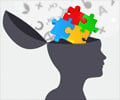Symptoms of autism result from danger signaling by mitochondria, say researchers.

Their theory is that a chronic "cell danger response" can interfere with brain development and function. Using a mouse model of autism, the researchers blocked the abnormal cell danger signals using a chemical compound. Doing so reversed the signs and symptoms of autism in the animal's brains and behavior.
In 2010, Autism Speaks awarded Dr. Naviaux a Trailblazer award to test his theory that it might be possible to reverse autism by blocking chronic cell danger signaling.
Several years ago, Dr. Naviaux proposed that cell structures, called mitochondria, play a broad role in the development of autism. Mitochondria are best known for providing cells with energy. Dr. Naviaux looked beyond energy production to study the mitochondria's role in signaling when a cell is damaged or diseased. Under stress, cells release mitochondrial, or "purinergic," chemicals that normally remain inside the cell. When they leak outside a cell, these chemicals signal danger to surrounding cells.
"In essence, these signals warn other cells to harden their defenses. This helps protect against cell-to-cell infection. However, it may also interfere with cell-to-cell communication. ," Dr. Naviaux explained.
Normally, healthy cells stop releasing these danger signals when an infection or other stress resolves. According to Dr. Naviaux's "cell danger response" theory, autism can result when a stress during early brain development triggers a chronic danger response.
Advertisement
"When the brain cells stop talking, so do children," he said.
Advertisement
The researchers measured social behavior by giving the mice opportunities to spend time with either another mouse or a Lego block in adjacent wire chambers. They also tested motor coordination as the mice walked along a rotating rod. While female pups showed only mild impairments, the male pups showed a 50 percent reduction in socializing and a 28 percent reduction in motor coordination.
The researchers then tested the male pups' response to treatment. When the mice were 6 weeks old (roughly adolescents), 84 received an injection of suramin, a chemical that blocks the mitochondria's extra-cellular signals. For comparison, another 84 mice received a dummy shot of saltwater. The suramin treatment restored socializing and motor coordination to normal levels. The researchers saw no such improvement in the mice injected with saltwater.
Later, the researchers examined the mice's brain tissue, looking for brain abnormalities associated with autism. These included abnormal cell connections (synapses) and high rates of cell death in an important class of neurons called Purkinje cells. They found elevated levels of all these abnormalities in the untreated mice. But they were not present in the mice treated with suramin.
In people, suramin can be used safely only for short periods, because it has potentially serious side effects.
"Our hope was to test this compound first in mice, then in a small clinical trial that will use just a single dose to determine whether this class of drugs is a good direction for developing safe and effective treatments," Dr. Naviaux said.
Detail of his work has been published in the journal PLOS-ONE.
Source-ANI













